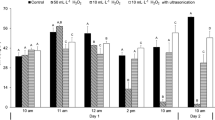Abstract
Cyanobacterial/Harmful Algal Blooms are a major issue for lakes and reservoirs throughout the U.S.A. An effective destructive technology could be useful to protect sensitive areas, such as areas near water intakes. The study presented in this article explored the use of a reactor called the KRIA Water Treatment System. The reactor focuses on the injection of superoxide (O2 −), which is generated electrochemically from the atmosphere, into the water body. In addition, the injection process generates a significant amount of cavitation. The treatment process was tested in 190-L reactors spiked with water from cyanobacterial contaminated lakes. The treatment was very effective at destroying the predominant species of cyanobacteria, Microcystis aeruginosa, organic matter, and decreasing chlorophyll concentration. Microcystin toxin concentrations were also reduced. Data suggest that cavitation alone was an effective treatment, but the addition of superoxide improved performance, particularly regarding removal of cyanobacteria and reduction of microcystin concentration.





Similar content being viewed by others
References
ASTM International (2013) ASTM D7348-13. Standard test methods for loss on ignition. In: LOI of solid combustion residuals, West Conshohocken
Beaver J, Manis E, Loftin K, Graham J, Pollard A, Mitchell R (2014) Land use patterns, ecoregion, and microcystin relationships in US lakes and reservoirs: a preliminary evaluation. Harmful Algae 36:57–62
Davis TW, Watson SB, Rozmarynowycz MJ, Ciborowski JJH, McKay RM, Bullerjohn GS (2014) Phylogenies of microcystin-producing cyanobacteria in Lower Laurentian Great Lakes suggest extensive genetic connectivity. PLoS One 9(9):e106093
Egan D (2014) Toxic algal blooms shuts off water, but green slime limited so far to Toledo. The Plain Dealer. http://www.cleveland.com/outdoors/index.ssf/2014/08/toxic_algal_bloom_shuts_off_wa.html
Environmental Sciences Section (ESS) (1991) ESS Method 150.1. Chlorophyll-spectrophotometric. Inorganic Chemistry Unit. Wisconsin State Lab of Hygiene, Madison. http://www.epa.gov/grtlakes/lmmb/methods/methd150.pdf
Heiskary S, Lindon M, Anderson J (2014) Summary of microcystin concentrations in Minnesota lakes. Lake Reserv Manag 30:268–272
Kunio F, Goro S, Takeshi N (1999) Method for water quality improvement of rivers, lakes, and ponds, and its device. Certificate of Patent. Japan Patent Office. Patent Number 3280643. Translated to English
Li P, Song Y, Yu S (2014) Removal of Microsystis aeruginosa using hydrodynamic cavitation: performance and mechanisms. Water Res 62:241–248
Makhera M, Gumbo JR, Chigayo K (2011) Monitoring of microcystin-LR in the Luvuvhu River catchment: implications for human health. Afr J Biotechnol 10:405–412
Medina VF, Morrow AB, Wade R (2016) Testing of the KRIA ionizing water treatment system for waters contaminated with diesel, PCBs, and nutrients (nitrogen forms). U.S. Army Engineer Research & Development Center Technical Note. ERDC/EL TR-16-03
Michalak AM, Anderson EJ et al (2013) Record-setting algal bloom in Lake Erie caused by agricultural and meteorological trends consistent with expected future conditions. PNAS 110(16):6448–6452
Mou X, Lu X, Jacob J, Sun S, Heath R (2013) Metagenomic identification of bacterioplankton taxa and pathways involved in microcystin degradation in Lake Erie. PLOS One 8(4):e61890. http://www.theguardian.com/commentisfree/2015/jul/27/alaska-global-warming-relocation?CMP=share_btn_tw
Oberholser PJ, Botha A-M, Cloete TE (2006) Toxic cyanobacteria blooms in a shallow, artificially mixed urban lake in Colorado, USA. Lakes Reserv Res Manag 11:111–123
Otten TG, Pearl HW (2015) Health effects of toxic cyanobacteria in the U.S. drinking and recreational waters: our current understanding and proposed direction. Curr Environ Health Rep 2:75–84
Persaud A, Paterson A, Dillon P, Winter J, Palmer M, Somers K (2015) Forecasting cyanobacteria dominance in Canadian temperate lakes. J Environ Manag 151:343–352
Ramani A, Rein K, Shetty KG, Jayachandran K (2012) Microbial degradation of microcystin in Florida’s waters. Biodegradation 23:35–45
Rivasseau C, Racaud P, Deguin A, Hennion M-C (1999) Evaluation of an ELISA kit for the monitoring of microcystins (cyanobacteria toxins) in water and algae water samples. Environ Sci Technol 33:1520–1527
Roelke DL, Brooks BW, Grover JP, and Lundgren VM (2013) Golden algae control: efficacy of hydraulic manipulations in covers of Lake Granbury. U.S. Army Engineer Research & Development Center Technical Report. ERDC/EL CR-13-1
Shephard GS, Stockenstrom S, DeVilliers D, Engelbrecht WH, Sydenham EW, Wessels GFS (1998) Photocatalytic degradation of cyanobacterial microcystin toxins in water. Toxicon 36:1895–1901
Wu Z, Shen H, Ondruschka B, Zhang Y, Wang W, Bremmer D (2012) Removal of blue–green algae using the hybrid method of hydrodynamic cavitation and ozonation. J Hazard Mater 235:152–158
Zhang GM, Hua I (2000) Cavitation chemistry of polychlorinated biphenyls: decomposition mechanisms and rates. Environ Sci Technol 34:1529–1534
Zimba PV, Khoo L, Gaunt PS, Brittain S, Carmichael WW (2001) Confirmation of catfish, Ictalurus punctatus (Rafinesque), mortality from Microcystis toxins. J Fish Dis 24:41–47
Acknowledgments
The authors would like to acknowledge the support of Premier Materials Technology, Inc. of Minneapolis, MN, who funded the project and the time to prepare this paper. Mr. Keith Boulais, CEO, was our primary contact. We also acknowledge the support by Mr. Mike Mangham of ECOUSA, who provided information on the operation of the KRIA reactor. A follow on project was funded by the Aquatic Plant Control Research Program, and some supplementary data were provided via this effort.
Author information
Authors and Affiliations
Corresponding author
Rights and permissions
About this article
Cite this article
Medina, V.F., Griggs, C.S. & Thomas, C. Evaluation of the Destruction of the Harmful Cyanobacteria, Microcystis aeruginosa, with a Cavitation and Superoxide Generating Water Treatment Reactor. Bull Environ Contam Toxicol 96, 791–796 (2016). https://doi.org/10.1007/s00128-016-1742-6
Received:
Accepted:
Published:
Issue Date:
DOI: https://doi.org/10.1007/s00128-016-1742-6




